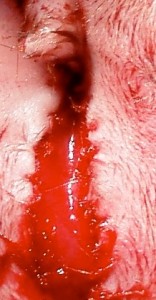Laryngeal paralysis commonly affects larger breed dogs that are usually relatively old. The cause is usually not identified.
The laryngeal folds are a little like curtains. Imagine that there is a wind blowing. The curtains can get “sucked” through an open door or window. The stronger the wind, the more likely they are to get sucked. In the same way the laryngeal folds get “sucked” into the airway. This is usually during breathing in and when the dog is excited or exercising. The airflow is faster at these times – the “wind” is blowing harder!!
These dogs present with breathing noises that sounds like sawing, and they often have a history of exercise or excitement-related collapse. The rationale for choosing surgical intervention is to improve the dog’s exercise tolerance and quality of life. It is essential that these dogs are kept as calm as possible pre-operatively. Owners need to avoid stressing and exciting the patient pre-operatively, and to avoid overheating to minimise stress and panting. Owners must allow plenty of time for travel, be prepared to stop, and let the dog calm down if necessary. We have had a couple arrive in severe states of collapse through stress in the car. Sedation under the direction of your own vet might be required in some cases.
We approach the larynx from the left side and we use sutures to hold the left laryngeal fold permanently out of the airway. This is the equivalent of tying one of the curtains back to stop it from blowing.



